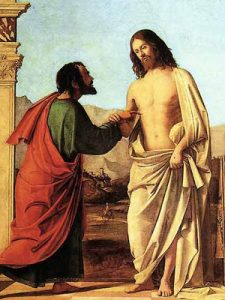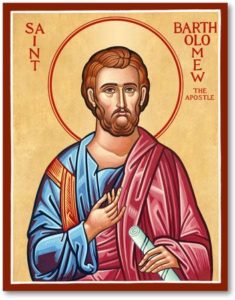Apostles
| Saint Thomas the Apostle | ||
|---|---|---|
 St. Thomas |
||
| Place of Birth: Galilee, Israel | ||
| State: | ||
| Date of Birth | ||
| Died On: 21 December 72 AD | ||
| Venerable: | ||
| Blessed: | ||
| Canonized: | ||
| Buried at: St. Thomas Cathedral Basilica, Chennai | ||
| Feast Day: July 3 | ||
St. Thomas was a Jew, called to be one of the twelve Apostles. He was a dedicated but impetuous follower of Christ. When Jesus said He was returning to Judea to visit His sick friend Lazarus, Thomas immediately exhorted the other Apostles to accompany Him on the trip which involved certain danger and possible death because of the mounting hostility of the authorities. At the Last Supper, when Christ told His Apostles that He was going to prepare a place for them to which they also might come because they knew both the place and the way, Thomas pleaded that they did not understand and received the beautiful assurance that Christ is the Way, the Truth, and the Life. But St. Thomas is best known for his role in verifying the Resurrection of his Master. Thomas' unwillingness to believe that the other Apostles had seen their risen Lord on the first Easter Sunday merited for him the title of "doubting Thomas." Eight days later, on Christ's second apparition, Thomas was gently rebuked for his scepticism and furnished with the evidence he had demanded - seeing in Christ's hands the point of the nails and putting his fingers in the place of the nails and his hand into His side. At this, St. Thomas became convinced of the truth of the Resurrection and exclaimed: "My Lord and My God," thus making a public Profession of Faith in the Divinity of Jesus. St. Thomas is also mentioned as being present at another Resurrection appearance of Jesus - at Lake Tiberias when a miraculous catch of fish occurred. This is all that we know about St. Thomas from the New Testament. Tradition says that at the dispersal of the Apostles after Pentecost this saint was sent to evangelize the Parthians, Medes, and Persians; he ultimately reached India, carrying the Faith to the Malabar coast. He capped his left by shedding his blood for his Master, speared to death at a place called Calamine. His feast day is July 3rd and he is the patron of architects.
| Saint Bartholomew the Apostle | ||
|---|---|---|
 |
||
| Place of Birth: Cana | ||
| State: | ||
| Date of Birth: | ||
| Died at: Albanopolis, Caucasia | ||
| Venerable: | ||
| Blessed: | ||
| Canonized: | ||
| Buried at: Basilica church of San Bartolomeo, Benevento, Italy | ||
| Feast Day: August 24 | ||
St. Bartholomew was one of the twelve apostles of Jesus according to the New Testament. He has also been identified as Nathanael or Nathaniel, who appears in the Gospel of John when introduced to Jesus by Philip (who also became an apostle; John 1:43–51), although many modern commentators reject the identification of Nathanael with Bartholomew.
According to the Synaxarium of the Coptic Orthodox Church of Alexandria, Bartholomew's martyrdom is commemorated on the first day of the Coptic calendar (i.e., the first day of the month of Thout), which currently falls on September 11 (corresponding to August 29 in the Julian calendar). Eastern Christianity honours him on June 11 and the Catholic Church honours him on August 24. The Church of England and other Anglican churches also honour him on August 24. The Armenian Apostolic Church honours Saint Bartholomew along with Saint Thaddeus as its patron saints. Bartholomew is English for Bar Talmai transliterated Bartholomaios in Greek) comes from the Aramaic: bar-Tolmay native to Hebrew "son of Talmai", or farmer, "son of the furrows". Bartholomew is listed among the Twelve Apostles of Jesus in the three synoptic gospels: Matthew,[10:1–4] Mark,[3:13–19] and Luke,[6:12–16] and also appears as one of the witnesses of the Ascension;[Acts 1:4, 12, 13] on each occasion, however, he is named in the company of Philip. He is not mentioned by the name "Bartholomew" in the Gospel of John, nor are there any early acta,[a] the earliest being written by a pseudepigraphical writer, Pseudo-Abdias, who assumed the identity of Abdias of Babylon and to whom is attributed the Saint-Thierry (Reims, Bibl. mun., ms 142) and Pseudo-Abdias manuscripts. In art Bartholomew is most commonly depicted with a beard and curly hair at the time of his martyrdom. According to legends he was skinned alive and beheaded so is often depicted holding his flayed skin or the curved flensing knife with which he was skinned. Mission to India Two ancient testimonies exist about the mission of Saint Bartholomew in India. These are of Eusebius of Caesarea (early 4th century) and of Saint Jerome (late 4th century). Both of these refer to this tradition while speaking of the reported visit of Pantaenus to India in the 2nd century.[11] The studies of Fr A.C. Perumalil SJ and Moraes hold that the Bombay region on the Konkan coast, a region which may have been known as the ancient city Kalyan, was the field of Saint Bartholomew's missionary activities.